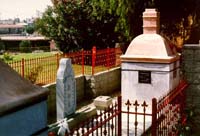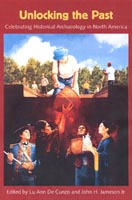The
Chinese in the Cities of the West
Roberta S. Greenwood

Shrine in Evergreen Cemetery, acquired, restored, and rededicated by Chinese Historical Society of Southern California
Over the centuries, America’s cities have become home to millions of immigrants. Some, like Africans, did not come of their own accord; many others did, seeking a new life. As we have come to appreciate this diversity represented in our North American heritage, historical archaeologists have learned to do more than simply count, weigh, and measure the artifacts people left behind. As our discipline has evolved, we have learned that much of the past still lies intact below our feet despite all the modern developments, highways, high rises, and parking lots. These remains, even when broken or disturbed, can fill in many of the chapters missing from our history books. In the nineteenth century, California hosted large populations of Chinese immigrants in urban Chinatowns, and smaller concentrations in work camps focused on railroad construction, fishing, or mining. Archaeologists are finding new evidence of their presence in areas that we once thought were hopelessly disturbed, and the sites are speaking to the diversity within the Chinese community. Rather than merely identifying soy sauce jars or attempting to arrange porcelain patterns in chronological sequence, we can now address more substantive issues about what people did, how behavior changed, and why.
More frequently than their rural counterparts, immigrants to the urban Chinatowns of the West settled down and prospered, even though isolated by language, crowded within land of low value, and subject to prejudice. They maintained traditional lifeways, especially regarding their foodways and important social and religious organizations. But archaeology has also revealed the presence of distinctive social and economic classes. Remains of the Chinese past in California survive under unlikely circumstances in areas where we thought they had been destroyed. These remains of buildings, landscape features, and artifacts clearly identify distinctions within Chinese immigrant society, and they are forcing us to challenge many traditional assumptions about Chinese life in California, on what the Chinese named Golden Mountain.
Roberta S. Greenwood is a research associate with the Los Angeles County Museum of Natural History and president of the consulting firm Greenwood and Associates..
